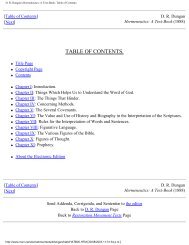Dungan - Hermeneutics
The Art and Science out interfering scripture.
The Art and Science out interfering scripture.
Create successful ePaper yourself
Turn your PDF publications into a flip-book with our unique Google optimized e-Paper software.
D. R. <strong>Dungan</strong>'s <strong>Hermeneutics</strong>: A Text-Book: Table of Contents.<br />
SEC. 62. METONYMY OF THE SUBJECT. (1) The subject put for the adjunct. (2) The<br />
container put for the contained. (3) The possessor, for the thing possessed. (4) The<br />
subject named, whereas something consequent thereupon, or connected therewith, is<br />
intended. (5) The thing signified put for the sign. (6) Actions said to be performed<br />
where only permitted or foretold. (7) Actions said to have been accomplished when<br />
only an occasion was given. (8) A statement made as complete when the thought is<br />
only comparative. 278<br />
SEC. 63. METONYMY OF THE ADJUNCT. (1) An accident, or an addition to the subject<br />
mentioned, whereas the subject was meant. (2) The thing contained put for the<br />
container. (3) Time put for the things that occur or happen. (4) Things spoken of<br />
according to appearance, opinions, or claims made for them. (5) Faith or feeling put<br />
for that which occasioned it. (6) A sign is put for the thing signified. (7) The names of<br />
things put for the things. 291<br />
SEC. 64. SYNECDOCHE. (1) The whole is put for a part. (2) A part put for the whole. (3)<br />
Time is put for a part of it. (4) The plural put for the singular. (5) The singular put for<br />
the plural--eat, walk, shoot, etc. (6) A large number for many. (7) A general name is<br />
put for a particular name. All flesh--Canaanites. (8) Sometimes a special name or<br />
word is put for a general. Many put for all. 300<br />
SEC. 65. PROVERB. Webster, Bacon, Wycliffe. Three features of value. How interpreted? 314<br />
SEC. 66. IRONY. How known. Statement of the author. Tone. Character of the speech.<br />
Extravagance. The opinion of those who were present. 316<br />
SEC. 67. SARCASM. Relation to irony. 318<br />
SEC. 68. HYPERBOLE. Webster. Oriental custom. 320<br />
SEC. 69. THE APOSTROPHE. Its origin. Address to the inanimate world--to absent or dead<br />
persons. 322<br />
SEC. 70. PERSONIFICATION. Inanimate things spoken of as animate. 324<br />
SEC. 71. INTERROGATION. Used to affirm or deny with emphasis. 326<br />
SEC. 72. PROLEPSIS. Webster, Bishop Bramhall, Theobald. Scripture use. 329<br />
SEC. 73. PARALLELISM. Its meaning and use among the ancients. 332<br />
SEC. 74. SYNONYMOUS PARALLELISM. (1) Identical. (2) Similar. 335<br />
SEC. 75. ANTITHETIC PARALLELISM. (1) Simple. (2) Compound. 337<br />
SEC. 76. SYNTHETIC PARALLELISM. (1) The corresponding. (2) Cumulative. (3)<br />
Descendent. (4) Irregular. 338<br />
CHAPTER X.<br />
FIGURES OF THOUGHT.<br />
SEC. 77. ANTITHESIS. Webster. Scripture use. 346<br />
SEC. 78. SYMBOLS. Meaning. Difference from the type. 349<br />
http://www.mun.ca/rels/restmov/texts/ddungan/hatb/HATB00C.HTM (8 of 10) [30/08/2003 11:31:43 p.m.]




